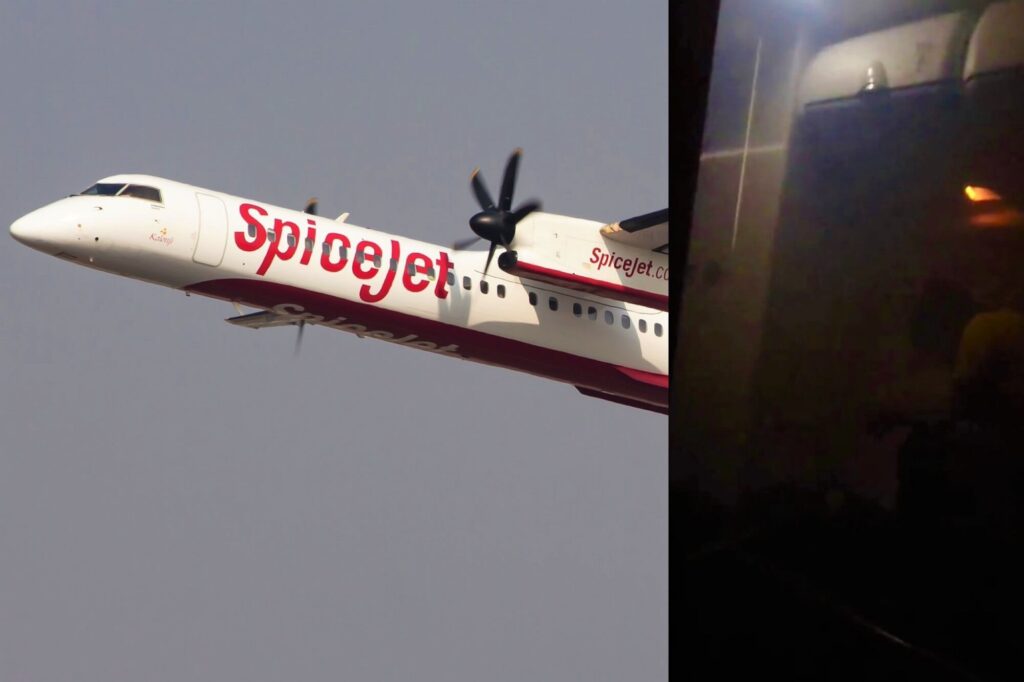India’s civil aviation regulator has ordered budget carrier SpiceJet to conduct a detailed inspection of its De Havilland Canada DHC-8-400 turboprop fleet, including an analysis of engine oil samples, after one of its planes made an emergency landing due to smoke in the cabin.
The new directive was reported by the Deccan Herald reported on October 17, 2022, citing a. statement issued by the Directorate General of Civil Aviation (DGCA).
Smoke in the cabin
The incident took place on October 12, 2022, when a SpiceJet Q400 turboprop, registered VT-SQB, was operating daily scheduled flight SG-3735 between Goa (GOI) and Hyderabad (HYD) in India.
According to Zee News India, the plane, which was carrying 86 travelers and crew onboard, was descending to its destination at Rajiv Gandhi International Airport (HYD), when the flight crew reported smoke in the passenger cabin. Since the aircraft was already close to the airport, it made an immediate emergency landing.
The plane landed safely at HYD airport, around 25 minutes after the abnormality was reported.
Why did oxygen masks not deploy?
While the plane was descending, one of the passengers captured the landing on video, which was later shared on Twitter. The footage showed passengers surrounded by heavy smoke with some struggling to breathe normally. A member of the cabin crew was also captured shouting an unclear emergency command, attempting to outvoice the aircraft alarm.
While most smoke and fire warnings turn out to be false, the footage sparked discussions on social media about whether the cabin crew could have taken more active actions to deal with the potentially life-threatening situation onboard.
@flyspicejet risks people’s life, we were choking for 25 mins and even oxygen masks didn’t deploy. Strict action should be taken against such a negligent airline. #spicejet @KTRTRS @DGCAIndia @JM_Scindia @ndtv @timesofindia @TV9Telugu pic.twitter.com/yPqNsiHeh9
— Vivek Vishal (@VivekVi97433075) October 15, 2022
Both witnesses and social media users were surprised that oxygen masks had not deployed in the presence of smoke and even accused SpiceJet of negligence.
“SpiceJet risks people’s lives, we were choking for 25 mins, and even oxygen masks didn’t deploy. Strict action should be taken against such a negligent airline,” one of the witnesses wrote on social media.
However, there is a reasonable explanation for why oxygen masks are not typically deployed in the passenger cabin.
Oxygen masks provide vital oxygen for both passengers and crew in a decreased air pressure environment and are usually armed to automatically deploy only when the passenger cabin exceeds a certain altitude. There are a variety of oxygen systems on aircraft, some of which are stored in containers under pressure. As spoke signals the presence of a potential fire onboard, it could be risky to activate passenger oxygen lines as they may provide an additional hazard.
The masks only increase oxygen concentration levels in the air provided to passengers but do not reduce the hazard of inhaling toxic fumes. While cabin oxygen masks provide supplementary oxygen, they also combine oxygen with cabin air, meaning that passengers who are drawing oxygen through the mask are also breathing in cabin smoke.
While there are no rules prohibiting flight crew from manually activating the masks, donating oxygen in case of smoke or fire onboard is not commonly recommended by the standard airline emergency procedures (SEP).
This could explain why no oxygen masks were deployed on the SpiceJet flight in question.
What caused the incident?
Immediately after the incident, the DGCA opened an investigation, which indicated evidence of engine oil in the bleed-off valve area. This could have led to engine oil entering the plane’s air conditioning system.
The regulator has also ordered SpiceJet to send engine oil samples from its Q400 fleet to Pratt & Whitney Canada, where they will be examined for the presence of metal and carbon seal particles. The DGCA reportedly said the air carrier must perform a detailed baroscopic engine inspection of its every Q400 turboprop, which should be conducted within a week from October 17, 2022.
The authority also insisted on an “immediate inspection of Magnetic Chip Detectors (MCD) for the presence of any metal particles on reporting of fault 938 in the central display system which otherwise is a class 2 fault.”
According to Planespotters.com data, SpiceJet currently has 32 De Havilland Canada DHC-8-400 in the fleet, out of which 17 are marked as temporarily parked.
